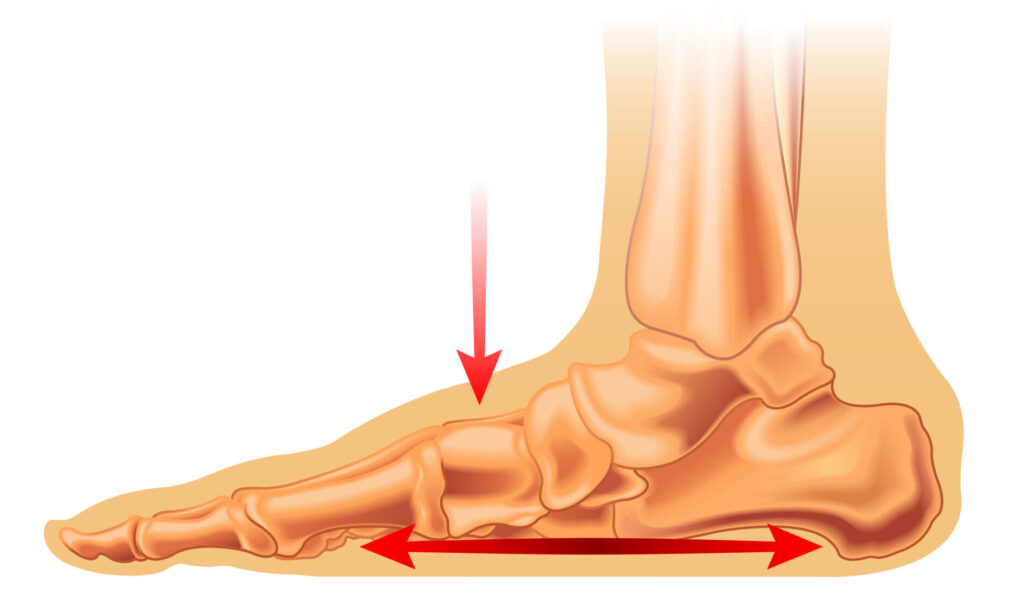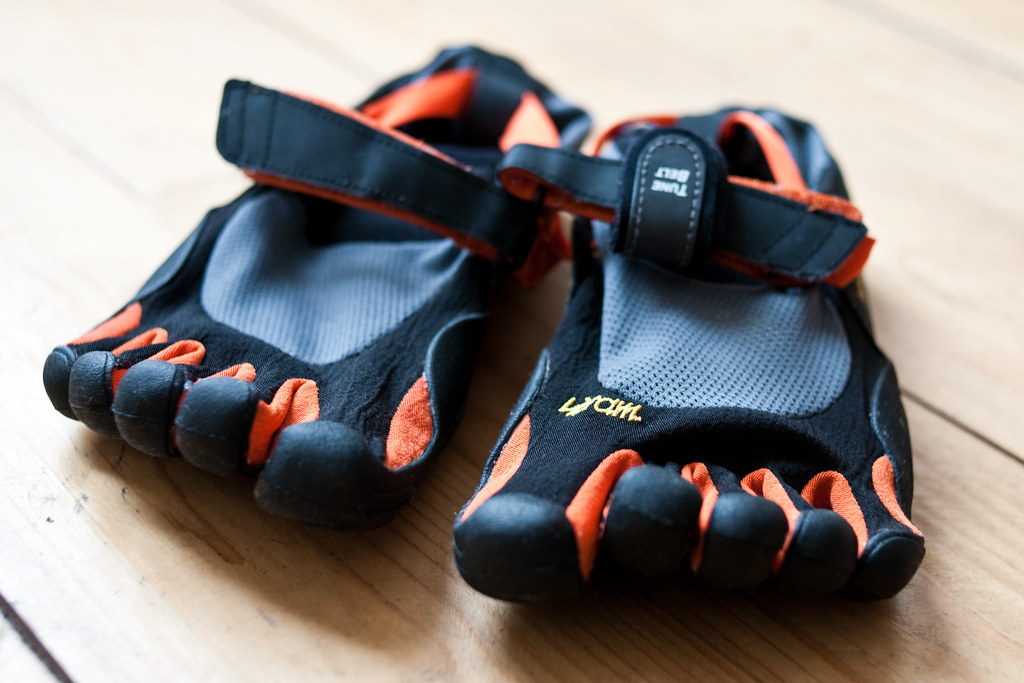With an estimated 20-30% of the population suffering from flat feet, many wonder if minimalist shoes could be the answer.
Evidence suggests that you CAN wear barefoot shoes if you have flat feet, provided you follow a gradual transition.

Here’s What You Need To Know About Barefoot Shoes And Flat Feet:
Barefoot shoes can fix flat feet by stimulating muscles in the feet, which are not used due to artificial support in traditional shoes.
Studies by Dr. Sarah Ridge [1] found that merely walking in minimalist shoes can strengthen foot muscles as much as participating in a foot-strengthening exercise program.
Equally, a study Eun-Kyung Kim and Jin Seop Kim [2] proved that strengthening the feet is more beneficial to fixing flat arches than arch support insoles.
Choosing the right barefoot shoes is CRITICAL! (I cover this further down)
You want to start out with a pair of shoes which offer a small amount of arch support, gradually working your way down to none at all.
While barefoot shoes may not be a universal solution for flat feet, they can benefit those willing to transition gradually.
A healthy transition can involve:
- Walking around the house with no shoes on
- Then wearing barefoot shoes indoors
- Venturing outdoors for short walks
- Attempting barefoot running
Check out this article for 7 easy tips for a pain free transition.
Understanding Flat Feet
Flat feet, also known as fallen arches, are when the entire sole of the foot makes contact with the ground when standing.

What Are The Causes Of Flat Feet?
We distinguish the two main causes:
| Flat feet | arches never developed during childhood |
| Fallen arches | caused by injury or simple ‘wear and tear’ in adults |
Flat feet can cause pain or discomfort in the feet, ankles, or knees.
This is due to the altered alignment and distribution of weight on your feet.
The arch of the foot plays a critical role in shock absorption, so lacking a proper arch can lead to increased stress on joints and muscles, especially when doing sport.
What Is The Conservative Treatment For Flat Feet?
Conservative treatment for fallen arches often includes expensive orthotic devices and exercises to strengthen the muscles in the feet.
Whilst the latter has been proven to help [2], orthotic devices, which tend to be very expensive, DON’T actually treat flat feet.
They simply reduce the pain by supporting the arch.
Understandably, this doesn’t strengthen the intrinsic muscles in your feet as they are doing even less work.
However, there are numerous accounts swearing by barefoot shoes as a solution.
Several examples of this appeared on a barefoot running group I follow on Reddit.
I cover this in more detail in another article, but here is one account of barefoot shoes fixing flat feet:
I used to have flat feet, then I started running barefoot and in VFF’s [Vibram Five Fingers], and now I don’t have flat feet.
shock absorption and flat feet can both be solved in one fell swoop by running properly. the achilles tendon and the muscles of the bottom of the foot are the main muscles used to handle the impact of each step. Over time these muscles strengthen and change shape into the arch of the foot.
User: crazymusicman
Are Barefoot Shoes Good For Flat Feet?
Going entirely barefoot or wearing barefoot shoes can be good for flat feet, as it allows them to function naturally, improving muscle strength and function.
Whilst there are many opinions on this topic, here’s what the science says:
Medical professionals [2] have proven that strengthening foot muscles is more beneficial to fixing flat feet than arch support insoles.
The thin, flexible sole found in barefoot shoes allows the foot to move and flex naturally.
This means that the foot muscles work harder, leading to increased strength over time.
Selecting Barefoot Shoes for Flat Feet
This section will discuss how to select the best barefoot shoes for those with flat feet. We will cover the features to consider and some popular brands and models.
Features To Look For:
If used correctly, barefoot shoes can provide support and comfort for those with flat feet.
You should consider the following features when looking for barefoot shoes:
- Minimal heel-to-toe drop: A low or zero-drop shoe will encourage a more natural gait (forefoot strike), working the foot more and building strength.
- Flexibility: The shoe should allow for natural foot motion, providing support without restricting movement.
- Arch support: You want a minimum level of arch support in your first few pairs. Look to gradually reduce this in each new pair.
Popular Minimalist Shoes For Flat Feet:
Based on recommendations by users who have fixed their flat feet, here are some popular barefoot models:
| Brand | Model | Recommended for |
|---|---|---|
| Brooks | PureGrit | Trail running, excellent transition shoes |
| Merrell | Bare Access XTR Trail | Beginners, road running and trail |
| Vibram | FiveFingers | More experienced barefoot runners |
I have written a full article explaining which barefoot shoes are best for people with flat feet. You can find it below:
Choosing The Right Size
It is commonly known that choosing barefoot shoes in the right size can be tricky!
A basic rule of thumb is: use your foot size, not your shoe size.
Here is a helpful guide to find perfect fit:
- Measure the length and width of your foot
- Length: allow for a small gap (approx. 12mm or 0.4 inch). This allows your foot to stretch and expand as you walk.
- Width: ideally you should add around 3mm or 0.1 inch to the width of your foot.
Potential Drawbacks and Concerns
Here are a few things to be aware of if you’re considering barefoot shoes:
Transition
I have mentioned it several times already in this article, but I cannot stress it enough;
A CORRECT TRANSITION IS KEY!
By not providing the right amount of arch support that your feet need, you could make the problem worse, causing pain and discomfort.
Gradually increase the time and mileage you spend in your shoes (or completely barefoot), and reduce the arch support in your shoes, over a long period.
It can take up-to a year for some people to fully transition, so don’t rush!
Independent foot strengthening
You should spend a few weeks working on strengthening your feet prior to wearing your new shoes.
This allows your underdeveloped foot muscles to strengthen before becoming heavily relied upon every time you walk.
Here are two exercises you can easily do at home:
- Towel toe grabs
- Marble pickups
Towel Toe Grab
This exercise strengthens your whole foot, especially your arches and toe flexor muscles, by engaging the intrinsic muscles of the feet.
- Sitting on a chair or stool, lay a small towel on the floor before you.
- Using your toes, grip it and hold for 6 seconds before releasing.
- Spread your toes to stretch out your arches, then relax and start the process again.
- Repeat at least five times.
In this video, Dr. Donald Ozello gives a demonstration on how to perform a towel to grab efficiently:
Marble Pickups
This exercise improves the coordination of your toes and strengthens your arches.
- Once again, sitting on a chair, place some marbles or other small objects (stones or coins) before you.
- Pick up the marbles one by one, moving them about 3 feet away.
- Once you have transferred all the marbles, move them back to where they were with your other foot.
- Repeat the exercise at least five times.
Here is a demonstration:
Barefoot Shoes May Not Always Be The Solution:
It must be said that some cases of flat feet are NOT so easily treated.
With severe cases requiring surgery, some people would be better off seeking professional medical advice.
Simply wearing barefoot shoes could end up doing more harm than good if your flat feet require more extensive treatment.
While barefoot shoes can provide numerous benefits for flat feet, they may not be a complete solution for the underlying issue.
You should always address the root cause of flat feet.
Conclusion
Barefoot shoes can be an excellent option if you have flat feet, as they allow the feet to function more naturally and help improve balance, posture, and overall foot strength.
One main advantage of wearing barefoot shoes is the development of foot strength; a study by Dr. Sarah Ridge in 2019 found that simply walking in minimalist shoes can strengthen foot muscles as much as a foot-strengthening exercise program.
When transitioning to barefoot shoes, it is important to do so gradually and listen to your body. If you have flat feet and haven’t experienced barefoot footwear before, you should visit a medical professional for advice on safely incorporating them into your routine.
In summary, barefoot shoes can offer several benefits to those with flat feet, including increased comfort, natural movement, and improved foot strength.
Sources
- Walking in Minimalist Shoes Is Effective for Strengthening Foot Muscles – Dr. Sarah Ridge (Birmingham Young University)
- The effects of short foot exercises and arch support insoles on […] flatfoot patients – National Library of Medicine
- Towel Toe Grab – Dr Donald Ozello
- Marble Pickup – KURU
- What are the best minimalist shoes for flat footed runners? – Reddit
FAQs
Q: Can barefoot shoes help with flat feet?
A: Yes, barefoot shoes can benefit those with flat feet by allowing the feet to function more naturally and improve muscle strength. However, it is essential to transition gradually and consult a medical professional before making the switch.
Q: What are the potential drawbacks of barefoot shoes for fallen arches?
A: Some potential drawbacks include increased stress on the muscles in the feet and legs, absence of arch support, increased risk of injuries due to direct contact with potential hazards on the ground, and lack of cushioning that might not provide enough shock absorption for some individuals.
Q: How to select the best barefoot shoes for those with flat feet?
A: When looking for barefoot shoes designed for flat feet, it’s essential to consider the following features: minimal heel-to-toe drop, flexibility, and arch support.


